Natural Deep Eutectic Extracts of Propolis, Sideritis scardica, and Plantago major Reveal Potential Antiageing Activity during Yeast Chronological Lifespan
- PMID: 36082083
- PMCID: PMC9448591
- DOI: 10.1155/2022/8368717
Natural Deep Eutectic Extracts of Propolis, Sideritis scardica, and Plantago major Reveal Potential Antiageing Activity during Yeast Chronological Lifespan
Abstract
Nowadays, the environmentally friendly approach to everyday life routines including body supplementation with pharma-, nutraceuticals and dietary supplements gains popularity. This trend is implemented in pharmaceutical as well as cosmetic and antiageing industries by adopting a newly developed green chemistry approach. Following this trend, a new type of solvents has been created, called Natural Deep Eutectic Solvents (NADES), which are produced by plant primary metabolites. These solvents are becoming a much better alternative to the already established organic solvents like ethanol and ionic liquids by being nontoxic, biodegradable, and easy to make. An interesting fact about NADES is that they enhance the biological activities of the extracted biological compounds. Here, we present our results that investigate the potential antiageing effect of CiAPD14 as a NADES solvent and three plant extracts with it. The tested NADES extracts are from propolis and two well-known medicinal plants-Sideritis scardica and Plantago major. Together with the solvent, their antiageing properties have been tested during the chronological lifespan of four Saccharomyces cerevisiae yeast strains-a wild type and three chromatin mutants. The chromatin mutants have been previously proven to exhibit characteristics of premature ageing. Our results demonstrate the potential antiageing activity of these NADES extracts, which was exhibited through their ability to confer the premature ageing phenotypes in the mutant cells by ameliorating their cellular growth and cell cycle, as well as by influencing the activity of some stress-responsive genes. Moreover, we have classified their antiageing activity concerning the strength of the observed bioactivities.
Copyright © 2022 Bela Vasileva et al.
Conflict of interest statement
The authors declare no conflict of interest.
Figures
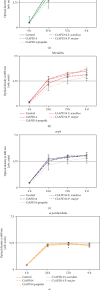
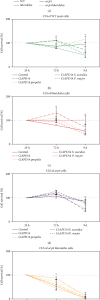
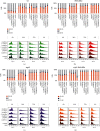
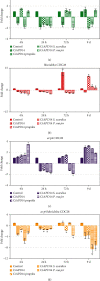
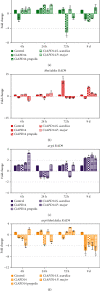

Similar articles
-
Extracts of medicinal plants with natural deep eutectic solvents: enhanced antimicrobial activity and low genotoxicity.BMC Chem. 2020 Dec 11;14(1):73. doi: 10.1186/s13065-020-00726-x. BMC Chem. 2020. PMID: 33308280 Free PMC article.
-
Natural deep eutectic solvents and aqueous solutions as an alternative extraction media for propolis.Food Res Int. 2019 Nov;125:108559. doi: 10.1016/j.foodres.2019.108559. Epub 2019 Jul 12. Food Res Int. 2019. PMID: 31554116
-
Broad range chemical profiling of natural deep eutectic solvent extracts using a high performance thin layer chromatography-based method.J Chromatogr A. 2018 Jan 12;1532:198-207. doi: 10.1016/j.chroma.2017.12.009. Epub 2017 Dec 6. J Chromatogr A. 2018. PMID: 29229334
-
Biobased natural deep eutectic system as versatile solvents: Structure, interaction and advanced applications.Sci Total Environ. 2023 Jul 10;881:163002. doi: 10.1016/j.scitotenv.2023.163002. Epub 2023 Mar 30. Sci Total Environ. 2023. PMID: 37003333 Review.
-
Natural Deep Eutectic Solvents: Properties, Applications, and Perspectives.J Nat Prod. 2018 Mar 23;81(3):679-690. doi: 10.1021/acs.jnatprod.7b00945. Epub 2018 Mar 7. J Nat Prod. 2018. PMID: 29513526 Free PMC article. Review.
Cited by
-
Propolis as a functional food and promising agent for oral health and microbiota balance: A review study.Food Sci Nutr. 2024 May 29;12(8):5329-5340. doi: 10.1002/fsn3.4216. eCollection 2024 Aug. Food Sci Nutr. 2024. PMID: 39139934 Free PMC article. Review.
-
Propolis as a Potential Therapeutic Agent to Counteract Age-Related Changes in Cartilage: An In Vivo Study.Int J Mol Sci. 2023 Sep 19;24(18):14272. doi: 10.3390/ijms241814272. Int J Mol Sci. 2023. PMID: 37762574 Free PMC article.
-
Exploring the Prospective Role of Propolis in Modifying Aging Hallmarks.Cells. 2024 Feb 24;13(5):390. doi: 10.3390/cells13050390. Cells. 2024. PMID: 38474354 Free PMC article. Review.
-
Investigation of antifungal and antibacterial potential of green extracts of propolis.Sci Rep. 2024 Jun 13;14(1):13613. doi: 10.1038/s41598-024-64111-7. Sci Rep. 2024. PMID: 38871855 Free PMC article.
-
Sideritis scardica Extracts Demonstrate Neuroprotective Activity against Aβ25-35 Toxicity.Plants (Basel). 2023 Apr 20;12(8):1716. doi: 10.3390/plants12081716. Plants (Basel). 2023. PMID: 37111938 Free PMC article.
References
-
- Troen B. R. The biology of aging. Mount Sinai Journal of Medicine . 2003;70(1):3–22. - PubMed
MeSH terms
Substances
LinkOut - more resources
Full Text Sources
Molecular Biology Databases

